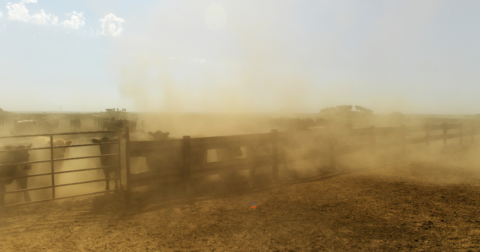News
Nearly Everyone Will Need to Change Their Diets by 2050 to Meet Climate Goals — Study Suggests
Research•4 min read
News
Factory farm dust can spread E. coli and could have sparked a large food poisoning outbreak in 2018, a new study shows.


Words by Natasha Gilbert
In 2018, contaminated romaine lettuce grown in Arizona led to one of the largest ever outbreaks of food poisoning from a dangerous strain of Escherichia coli bacteria. The strain, called Shiga toxin-producing E. coli (STEC), makes a poison that causes mild to life-threatening gastrointestinal illness in people. The outbreak led to illness in 210 people across 36 states, including 5 deaths and 96 hospitalizations.
A new study shows that the 2018 outbreak of toxic E. coli could have originated from a nearby cattle feedlot and been carried in the air to adjacent lettuce fields. The toxic bacteria live happily in the guts of cattle and are shed in their feces, causing the animals no ill health.
The new study is a “really significant and important scientific advancement,” says Chris Heaney, an environmental epidemiologist at John Hopkins University who has studied airborne transfer of pathogens from swine feeding operations and how they affect the health of local communities. It demonstrates that animal feedlots are an important source of foodborne human pathogens. And it adds weight to concerns of a loophole in the food safety system that prevents the Food and Drug Administration from entering animal feedlots to investigate the possible source of these pathogens.
The study was published in September in the journal Science of the Total Environment.
The new research, led by scientists at the U.S. Food and Drug Administration (FDA) as part of their investigations into the outbreak, shows that toxic E. coli can spread downwind in dust from cattle feedlots to surrounding areas. The goal of the research wasn’t to determine the source of the 2018 outbreak, but rather to better understand the potential risk of toxic E. coli in cattle feedlot dust dispersing in air to nearby fields.
Previously, other researchers have found some links between toxic E. coli and cattle feedlots. For example, a 2015 study found more STEC in samples taken at locations closer to a cattle feedlot than in samples taken from spots further away. The research also found E. coli in the air up to 180 meters away from animal feedlots. But this study didn’t detect the STEC pathogen in the air.
The new study connects all the dots. “In this study, we detected both STEC and cattle pen soil together in air samples,” which demonstrates that the toxic bacteria and soil are moving together in the air, the study’s authors told Sentient in an email.
In an initial assessment in the wake of the 2018 outbreak, the FDA concluded that the lettuce was most likely contaminated by bacteria-laced water from an irrigation canal. However, the FDA wrote that it couldn’t rule out other routes through which the bacteria wound up on the leafy greens, including airborne dispersal.
Produce is often identified as the source of outbreaks of E. coli or Salmonella, another foodborne illness. But bacteria don’t spontaneously appear. They come from cattle and other ruminant animals and can then move to produce, says Steven Roach, safe and healthy food program director at the Food Animal Concerns Trust.
There is a “crazy hole in our food safety system” that prevents the FDA from entering Confined Animal Feeding Operations (CAFOs) to sample for pathogens that have caused an outbreak in people, says Roach. This limits the FDA’s ability to investigate the origins of foodborne illness in people, he says.
A bill has been introduced at least three times in Congress to address the problem, first in 2019 following the STEC outbreak and most recently in February 2025. But the bill has not moved forward.
The FDA-led researchers went to great lengths to demonstrate the links between STEC in cattle lot dust and its movement downwind to nearby fields, says Roach.
Over a period of 3.5 years, the researchers collected air samples at 22 locations at distances up to 4.94 kilometers from a CAFO that houses over 100,000 cattle in southwest Arizona.
The researchers were not allowed to take samples from the CAFO. Instead, they used samples from cattle pens at the Desert Research and Extension Center in Holtville, California.
They analyzed microbial and genetic material in the air samples and in the feedlot soil. They found that air samples containing genes that code for the Shiga toxin also had genetic material from cattle, soil from cattle pens including feces and a higher proportion of the types of bacteria found in feedlot soil.
The researchers showed that the more cattle genetic material and cattle pen soil they found in air samples, the more Shiga toxin genes they also found.
They also discovered a bacterium, Corynebacterium maris, that was often present in cattle feedlot soil samples. The researchers also frequently found C. maris in the air samples that contained genes that make E. coli virulent. In the future, scientists can simply test for this bacterium to indicate that cattle pen soil is present and possibly also pathogenic E. coli without having to carry out the type of extensive sampling featured in this study.
The study findings counter earlier work funded by the cattle industry that questioned the role of CAFOs as the source of pathogen outbreaks on leafy greens. The National Cattlemen’s Beef Association did not respond to a request for comment.
The FDA-led researchers say it would have been helpful to their project to have access to the CAFO to take samples. Roach says he hopes the study’s findings will bring renewed attention to fixing the country’s broken system for food safety.
The findings demonstrate that it is important to consider movement of foodborne pathogens downwind from CAFOs when assessing risks to food safety, the FDA-led researchers wrote in an email.
It could also help inform decisions about where to grow crops or what safety measures such as trees as barriers might help prevent the airborne spread of pathogens from CAFOs, says Roach.
The findings will support more comprehensive investigations of future outbreaks and possibly help hold to account those responsible, the FDA-led researchers say.